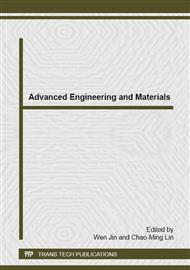[1]
L. Kaščák, J. Brezinová, M. Halama, J. Viňáš, Quality evaluation of resistance spot welds of hot-dip galvanized sheets in corrosive environment, Chem. Listy 105 (2011) 709-712.
Google Scholar
[2]
L. Kaščák, E. Spišák, Effect of welding parameters on the quality of spot welds combining AHSS steel and HSLA steel, Key Eng. Mat. 586 (2014) 162-165.
DOI: 10.4028/www.scientific.net/kem.586.162
Google Scholar
[3]
P. Hrabe, M. Muller, Application of spot welding under conditions of southeast asia, Eng. Rural Develop. 13 (2014) 58-62.
Google Scholar
[4]
G. Meschut, V. Janzen, T. Olfermann, Innovative and highly productive joining technologies for multi-material lightweight car body structures, J. Mater. Eng. Perform. 23 (2014) 1515-1523.
DOI: 10.1007/s11665-014-0962-3
Google Scholar
[5]
Z. Gronostajski, S. Polak, B. Bartczak, Joining of high-strength steel sheets by clinching, Steel Res. Int. Spl. Issue (2012) 611-614.
Google Scholar
[6]
M. Ambrozinski, A. Niechajowicz, Z. Gronostajski, R. Kuziak, W. Chorzepa, M. Pietrzyk, Numerical simulation of manufacturing of the crash box made of DP steel, Steel Res. Int. Spl. Issue (2012) 1291-1294.
Google Scholar
[7]
N. Nong, O. Keju, Z. Yu, Q. Zhiyuan, T. Changcheng, L. Feipeng, Research on press joining technology for automotive metallic sheets, J. Mater. Process. Technol. 137 (2003) 159-163.
DOI: 10.1016/s0924-0136(02)01083-x
Google Scholar
[8]
J. Mucha, Ľ. Kaščák, E. Spišák, Joining the car-body sheets using clinching process with various thickness and mechanical property arrangements, Arch. Civ. Mech. Eng. 11 (2011) 135-148.
DOI: 10.1016/s1644-9665(12)60179-4
Google Scholar
[9]
Y. Gao, Z. -X. Liu, P. -C. Wang, Effect of aging on the strength of clinching galvanized SAE1004 steel, J. Manuf. Sci. Eng. 136 (2014) doi: 10. 1115/1. 4027596.
DOI: 10.1115/1.4027596
Google Scholar
[10]
Y.H. Abe, S. Nishino, K. Mori, T. Kato, Improvement of Joinability in Mechanical Clinching of Ultra-High Strength Steel Sheets Using Counter Pressure, Adv. Mat. Res. 966 (2014) 607-616.
DOI: 10.4028/www.scientific.net/amr.966-967.607
Google Scholar
[11]
W.G. Drossel, T. Falk, M. Israel, F. Jesche, Unerring Planning of Clinching Processes through the Use of Mathematical Methods, Key Eng. Mat. 611 (2014) 1437-1444.
DOI: 10.4028/www.scientific.net/kem.611-612.1437
Google Scholar
[12]
M. Israel, The suitability of analytical and numerical methods for developing clinching processes with thick sheet metal, Adv. Mat. Res. 907 (2014) 151-163.
DOI: 10.4028/www.scientific.net/amr.907.151
Google Scholar
[13]
L. M. Alvesa, E. J. Diasb, P. A.F. Martins, Joining sheet panels to thin-walled tubular profiles by tube end forming, J. Clean. Prod. 19 (2011) 712-719.
DOI: 10.1016/j.jclepro.2010.12.014
Google Scholar
[14]
B. Bartczak, D. Gierczycka-Zbrożek, Z. Gronostajski, S. Polak, A. Tobota, The use of thin-walled sections for energy absorbing components: a review, Arch. Civ. Mech. Eng. 10 (2010) 5-19.
DOI: 10.1016/s1644-9665(12)60027-2
Google Scholar
[15]
Z. Gronostajski, S. Polak, Quasi-static and dynamic deformation of double-hat thin-walled elements of vehicle controlled body crushing zones joined by clinching, Arch. Civ. Mech. Eng. 8 (2008) 57-65.
DOI: 10.1016/s1644-9665(12)60193-9
Google Scholar
[16]
J. Mucha, W. Witkowski, The clinching joints strength analysis in the aspects of changes in the forming technology and load conditions, Thin Wall. Struct. 82 (2014) 55-66.
DOI: 10.1016/j.tws.2014.04.001
Google Scholar
[17]
J. Mucha, L. Kaščák, E. Spišák, The experimental analysis of forming and strength of clinch riveting sheet metal joint made of different Materials, Adv. Mech. Eng. (2013) doi: http: /dx. doi. org/10. 1155/2013/848973.
DOI: 10.1155/2013/848973
Google Scholar
[18]
X. He, L. Zhao,H. Yang, B. Xing, Y. Wang, C. Deng, F. Gu, A. Ball, Investigations of strength and energy absorption of clinched joints, Comp. Mater. Sci. (2014) doi: 10. 1016/j. commatsci. 2014. 01. 056.
DOI: 10.1016/j.commatsci.2014.01.056
Google Scholar
[19]
B. Bartczak, J. Mucha, T. Trzepieciński, Stress distribution in adhesively-bonded joints and the loading capacity of hybrid joints of car body steels for the automotive industry, Int. J. Adhes. Adhes. 45 (2013) 42-52.
DOI: 10.1016/j.ijadhadh.2013.03.012
Google Scholar


